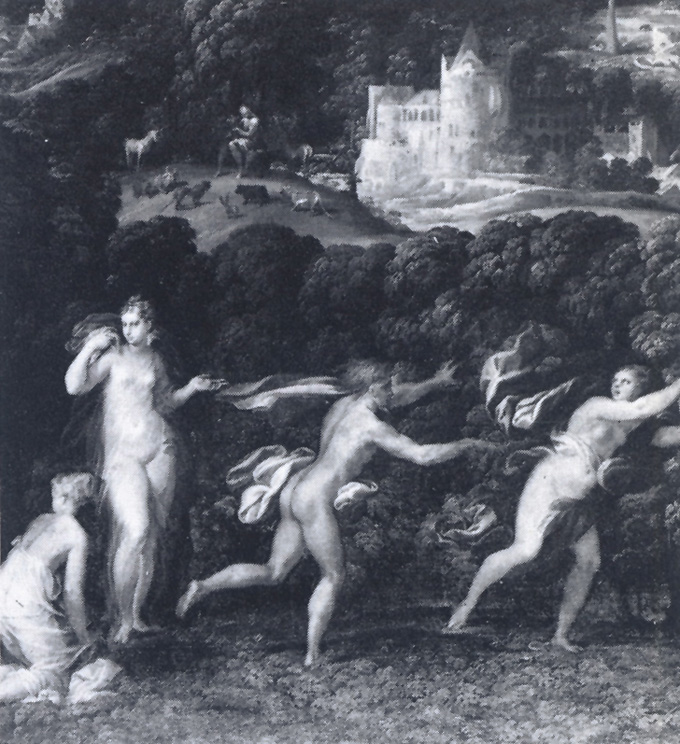
Abbate The Story of Aristaeus (detail) c. 1557
Aaltonen Waïnö (1894–1966). Finnish sculptor and painter and a major force in modern Finnish sculpture. His work in granite is classical in line despite its monumental character. Besides a number of female torsos and portrait heads, A. executed public monuments.
Abbate Niccolo dell’ (c. 1512–71). A Modenese painter who, from 1552, worked in France and was, with Primaticcio, a leader of the school of Fontainebleau. A. was stylistically influenced by the illusionism of Mantegna and the softness of Correggio, but more important was his characteristically Mannerist treatment of landscape, as in the Rape of Proserpine. There are similarities in his work to Dosso Dossi and also Patenier and the Antwerp school, and A. himself introduced Mannerism in landscape into France. A major picture is The Story of Aristaeus.

Abbate The Story of Aristaeus (detail) c. 1557
Abbey Edwin Austin (1852–1911). U.S. oil painter, watercolourist and book ill., who worked much in Britain, becoming an R.A. in 1898. He drew ills in pen for works by Robert Herrick, Oliver Goldsmith and Shakespeare, and painted the scenes of The Quest of the Holy Grail on the walls of the public library, Boston, Mass.
Abbott John White (1763–1851). British amateur landscape painter. He exhibited oils regularly at the R.A.; his drawings have been admired.
Abbott Lemuel Francis (c. 1760–1803). British portrait painter, known for his portraits of Lord Nelson and the poet Cowper.
Abil(d)gaard Nicolai Abraham (1743–1809). Danish painter who studied in Italy (1772–79). His style was classical and he favoured heroic subjects. He painted little after 4 allegorical frescoes by him in the Royal Palace, Copenhagen, which he considered his best work, were burnt in 1794. Sketches of these together with many other works are preserved in the Royal Gallery, Copenhagen. B. Thorwaldsen was his pupil.
Aboriginal art. Australian Aboriginal art
Abramtsevo Colony. A group of Russian artists drawn together in the 1870s and 1880s by the railway tycoon S. Mamontov. They included I. Levitan, V. Polenov, Repin, Serov, the Vasnetsov brothers and Vrubel. A number were members of the Wanderers group. The colony was nationalistic in outlook and Russian folk-art and the Russo-Byzantine tradition influenced their work. They were the 1st Russian artists to work as theatrical designers, most of them working in Mamontov’s ‘Private Opera’.
Abstract art. Art which does not imitate or directly represent external reality: some writers restrict the term to non-figurative art, while others use it of art which is not representational though ultimately derived from reality. Various alternatives have been suggested (non-representational art, non objective art, concrete art) but none has been generally accepted. ‘Abstract’ is frequently used as a relative term, paintings being more or less abstract in treatment. The original source of an abstract painting, e.g. a landscape or still-life, may be visible or decipherable: most Cubist painting is of this sort. Simplified or geometric shapes which have no direct reference to external reality may be used exclusively, as in Mondrian’s art. In a 3rd type of abstraction, brush-strokes, the colour and textures of the material used suggest the development of the painting, as in Pollock’s work.
The idea that forms and colour in themselves can move the spectator underlies all A. a. Much 20th-c. painting and sculpture has attempted to have, like music, no representational purpose. Sources and parallels for this art have been found in ceramic decorations, decorative patterns in manuscripts and the applied arts (especially Celtic art, e.g. The Book of Kells), Mohammedan art, primitive and tribal sculpture and non-realistic elements in European painting (e.g. simplified architectural backgrounds in paintings by Fra Angelico).
20th-c. A. a. springs from Cézanne who treated some landscape motifs as geometric solids, and whose painting was much admired by the Cubists. Cubism, the 1st abstract style, had a decisive effect on other artists and groups. The independent value of colour was not emphasized by Cubism, but by other groups. Flat pattern design in pictures, used by Gauguin and the Pont-Aven painters, was taken up by the Nabis; the Fauves were particularly interested in colour. The 1st non-figurative painting was made by Kandinsky in 1910, but before this there were several painters in some of whose work the subject had become virtually indistinguishable, for example Hölzel and Gustave Moreau. The emotional impact of colour was also of the first importance for German Expressionism. Cubism was followed and rivalled by Futurism in Italy, Vorticism in Britain, De Stijl in the Netherlands and various forms of abstraction in Russia, including the Rayonism of Goncharova and Larionov, Constructivism, and the rigid geometric A. a. of Malevich (Suprematism). Abstraction of various sorts became more common in the paintings and sculptures of the 1920s, having for the most part a geometric basis: exceptionally Arp had made some chance compositions (e.g. with torn paper), and in Surrealism there was some experiment with more informal types of abstraction. The main trend of A. a. in the 1930s was geometric, and the Abstraction-Création group was formed in 1932 to exhibit such art. This abstract salon was succeeded after the war by Salon des Réalités Nouvelles. In abstract painting since the war informal compositions and innovations in technique have been more frequent and the main movement is Abstract Expressionism. Sculpture during the 20th c. has been frequently abstract, particularly in the work of several major figures such as Arp, Brancusi and Calder.
Abstract Expressionism. A term 1st used in 1919 to describe certain paintings by Kandinsky – commonly applied to U.S. non-geometric abstract art by diverse artists centred mainly in N.Y. c. 1942 and highly active and influential through the 1950s and early 1960s. The U.S. critic Robert Coates used this term in 1946 with particular reference to De Kooning, Pollock and their followers. It was officially recognized in the 1951 Museum of Modern Art exhibition ‘Abstract Painting and Sculpture in America’. The term embraces works of diverse styles and degrees of reference to content or subject, emphasizing spontaneity of expression and individuality. The U.S. critic Rosenberg used the term ‘Action painting’ (1952), while Greenberg that of ‘American-type painting’ (1952) to refer to the same general types of artistic activity which, however, began to be differentiated into two tendencies: brush painting concerned with gesture, action and texture (De Kooning, Pollock); Color-field painting concerned with a large unified shape or area of colour (Newman, Rothko, Still).
Abstraction-Création. School of non-figurative art founded in Paris in 1931 by A. Pevsner and N. Gabo, under the leadership of A. Herbin and Vantongerloo. It has not attempted a full synthesis of the plastic arts but rather a merging of some of the techniques of painting and sculpture.
academic art. The term applies to art in a well-established, often realistic, tradition, showing expert command of draughtsmanship and other techniques. In the 19th c. the academies of painting became centres of opposition to new movements so that a. a. now generally has the pejorative overtones of ‘conservative’ and ‘unimaginative’.
academies. Institutions which derive their name from Plato’s Academy. In effect they originated in 15th-c. Italy, where humanist gatherings quickly attracted the official patronage, e.g. the famous Accademia Platonica founded by Cosimo I of Florence (c. 1542), which became a frequent feature of subsequent bodies. Vasari’s Accademia di Disegno (1562) aimed to establish the status of artists (a frequent motive of these foundations); but many were essentially teaching organizations, e.g. the academy of the Carracci. By 1870 over 100 academies were flourishing in Europe indicating the growing awareness of reintegrating the arts and society. Among British institutions, examples are the Royal Academy of Music (R.A.M.; 1922), the Royal College of Music (R.C.M.; 1873) and the Royal Academy of Dramatic Art (R.A.D.A.; 1904). Literary academies have sometimes functioned as arbiters of language. In this respect the Académie Française, founded by Richelieu in 1635, is pre-eminent. It has, however, been accused of undue conservatism, and has excluded many great French writers, including Molière, Balzac and Flaubert. In painting the same kind of criticism has been levelled at the British Royal Academy (R.A.; 1768; many British painters were trained in its schools) and the French Académie Royale des Beaux-Arts (founded by Louis XIV in 1648, dissolved in 1793 and reinstated in 1816 as the Académie des Beaux-Arts). The British Academy (1901) is devoted to scholarship in many fields.
Acconci Vito (1940– ). U.S. artist, 1st noticed as a poet (1964–8), who then turned to Performance, Installation and Action and Body art (1969) attracted by the experimentation of groups such as The Judson Church, and the conceptual framework established by such artists as LeWitt, Andre, R. Morris, Kosuth, Weiner, D. Graham, Oppenheim and Burden. His most notorious work in the 1970s was Seedbed (1972) in which he lay under the floor of the gallery loudly voicing his sexual fantasies while masturbating. In the 1980s he started making constructions, e.g. Sub-Urb (1983) and furniture, e.g. Sleeping Dog Couch (1984).
Ackermann Rudolf (1764–1834). German art publ. and bookseller who opened a shop in the Strand, London, in 1795. He introduced art lithography to Britain, 1817. A. publ. various ill. magazines, e.g. Repository of Arts, Literature, Fashions, etc., topographical books, e.g. History of the University of Oxford (2 vols, 1814), The Microcosm of London (3 vols, 1808–11), and many travel books, employing artists such as Rowlandson and A. Pugin. The illustrated annual Forget-me-not (begun 1825) was another of A.’s typographic and artistic successes.
Action and Body art. Term used of certain art manifestations of the late 1960s, making use of the body, or direct reference to it, also involving actions by its exponents on their own bodies, or public performances calculated to shock or bore and so prompt consideration of the tedium and violence of life. Instances include patterned sun-burning, the taking of casts of limbs, e.g. B. Nauman’s From Hand to Mouth (1967), a 12-hour lecture by Beuys, self-mutilation, and shocking or obscene exhibitionism.
Action painting. A term first used by U.S. critic Rosenberg to describe a method of painting widespread in the 1950s and 1960s, in which the paint is dripped, dropped or thrown on the canvas – hence the French term Tachisme (tache, ‘stain’ or ‘spot’); some critics use both terms as interchangeable with Abstract Expressionism. The term was first used about the work of Pollock but has also been applied to European artists associated with Tachisme.
Adam Lambert-Sigisbert (1700–59). French Baroque sculptor, son of the sculptor Jacob-Sigisbert A. (1670–1747). In Rome (1723–33), he was strongly influenced by Bernini. His fountain Triomphe de Neptune et d’Amphitrite (1740) is at Versailles.
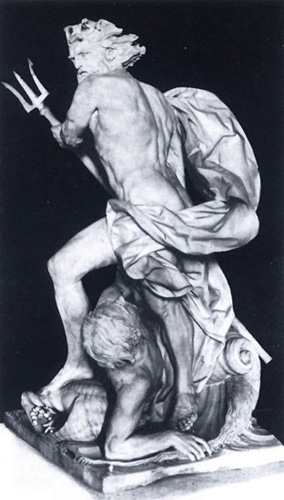
Adam Neptune Calming the Waves 1737
Adami Valerio (1935– ). Italian painter sometimes associated with European Pop art. His paintings, frequently of bourgeois interiors, are in flat, bold colours, with objects outlined by strong, black lines. This allows an ironic play between figurative subject matter and abstract forms.
Adams Herbert (1858–1945). U.S. sculptor who studied in Paris. A.’s work includes the tympanum of St Bartholomew’s Church, N.Y. (1902).
Adam-Salomon Antony-Samuel (1818–81). French portrait photographer and sculptor. His photographs with their use of heavy chiaroscuro effects were praised for their approximation to 17th-c. Dutch paintings.
Adler Jankel (1895–1949). Polish painter. His figure studies were influenced by Picasso and Léger. He travelled widely in Europe teaching for a time at the Düsseldorf Academy with Klee and working with Hayter at Atelier 17.
Aelst Willem van (1625/26–83?). Dutch still-life painter from Delft. He was a good draughtsman and vivid colourist. A.’s still-lifes are distinguishable from those of other Dutch painters, being frequently littered with bric-à-brac of Renaissance antiquarianism.
Aertsen (Aartsen, Aertszen, Aertsz) Pieter (Pier Lange) (1507/8–75). Dutch painter, working in Antwerp and Amsterdam, whose detailed and colourful genre and still-life paintings were highly popular and also stylistically influential on the 17th-c. Netherlands genre school. Many of his religious paintings have been destroyed.
Aesthetic movement. British literary and artistic movement of the 1880s in protest against the idea that art must serve some ulterior purpose and also against the ‘philistine’ taste of the period. W. Pater was its most important member but Oscar Wilde its most vocal. The A. m. was ridiculed by Punch and in Gilbert and Sullivan’s operetta Patience.
aesthetics. The study of the concepts of ‘beauty’ and ‘art’. A. attempts to give an account of the human reaction to beauty and art, to define the words, to explain how men perceive the ‘beautiful’ or the ‘artistic’, to decide whether the concepts have any other than a subjective meaning and to explain what happens when a man stands before a ‘beautiful’ sight or a work of ‘art’ – what kind of experiences he has and in what way he is able to ‘experience’ anything. Although the writings of Plato and Aristotle contain observations on the subject matter of a., the word was first used by the 18th-c. German philosopher A. G. Baumgarten. Some of the most prominent theoreticians in a. since the 19th c. include Winckelmann, I. Kant, Lessing, J. Schiller, G. Hegel, J. G. Herder, F. Schelling, Ruskin, Baudelaire, Taine, F. Nietzsche, Croce, Worringer and Gombrich.
African art. The term refers only to black African art and particularly to sculpture and carving (mostly in wood) from the vast area surrounding the Niger and Congo basins. Ancient Egyptian art and bushman painting from southern Africa are thus excluded. Distinction must be made between the courtly art (especially from Ife and Benin) which tended to be naturalistic and commemorative, and made in durable materials (stone, terracotta, bronze, hardwood); and the conceptual, often abstract art consisting mainly of wood-carvings (masks, ancestor figures) used during religious ceremonies. It was work of the 2nd kind which made its impact on Western artists at the beginning of the 20th c.
All the tribal artists were inspired by similar beliefs. In African ‘animist’ religions ‘being’ is regarded as vital energy and not solely as the living state. Every existing thing has a vital force or energy and by understanding and correctly approaching these forces man can use them, but in order to ensure the continuance and increase of this vital energy in the tribe and in himself he must perform religious rituals at regular intervals and on set occasions. Masks and statues are used in communication with the spirit world, in the cult of the ancestors and as protective charms in the direct exploitation of the vital energy in the world.
The artist works within a formal convention to embody in his carving some concept related to the subject and to give his carving a dynamic power, so that it can be used to enlist and generate energy. He therefore does not aim to reproduce his subject realistically nor is his 1st intention to produce ‘beautiful’ forms. The head of the statue is often disproportionately large owing to the belief that it is the seat of the life force and is therefore more important than the body. Statuettes are almost always made from a single block from a tree, thus leading to elongation of the body with the arms held close to the sides, and foreshortening of the features. Ashanti, Bakuba, Baluba, Bambara, Ba(o)ule, Dahomey, Dogon, Fang, Mende, Nok and Yoruba.
Afro-Cubanism. Early 20th-c. trend in Cuban music, literature and painting. It evolved from the European avant-garde’s interest in primitive art and the writings of the anthropologist Fernando Ortiz, notably Los negros brujos (1906). There were parallel movements in Puerto Rico and Haiti.
Agar Eileen (1899–1991). Born in Buenos Aires, settled in Britain 1911. Prominent among British Surrealist painters, who also made sculptures and assemblages; her work was included in the International Surrealist Exhibition, London 1936, and all other subsequent major exhibitions surveying Surrealism.
Agnolo Andrea d’. Andrea del Sarto
Agostino di Duccio (1418–81). Florentine sculptor mainly of reliefs, possibly a pupil of J. della Quercia. His earliest independent work was probably the altar (completed by 1442) in Modena cathedral. His major work is at the Tempio Malatestiano, Rimini (architect Alberti, painter Piero della Francesca). A.’s style is essentially linear, his relief work is flat with no attempt at illusionism.
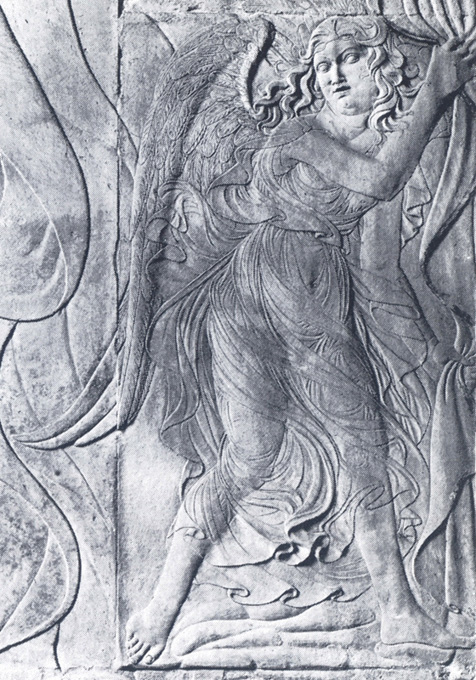
Agostino di Duccio Angel (relief from the Tempio Malatestiano, Rimini) c. 1447–c. 1454
airbrushing. A method of painting by means of a fine paint or varnish spray, used primarily in commercial and graphic arts to achieve a smooth flat finish, or gradations of colour. Some Pop and Super Realist artists also use it.
Ajanta cave paintings (Hyderabad state, India). A series of wall paintings, dating from the 1st to the 7th c. AD, of which only parts now survive. They depicted scenes in the life of the Buddha and the Jataka stories of his former lives, scenes from contemporary life and animals and plants. The handling is sure and subtle, the line controlled, the colour vivid and well contrasted and the presentation, a somewhat stylized realism, ignores perspective. There are also carved pillars and sculptures.
AKhRR. Vkhutemas
alabaster. A natural stone used for statues and ornamental carving. It is a granular form of gypsum, usually white, pink or yellowish in colour and very soft. The best sort is pure white and translucent but it can be made nearly opaque to resemble marble by heating it in almost boiling water. It was extensively used in the medieval and Renaissance periods. In the late 14th c. and 15th c. English work, particularly that of Nottingham, had a European reputation. Being soft, a. allows a more delicate style of carving than is possible in stone.
Albani Francesco (1578–1660). Italian painter working at Bologna and Rome and popular with his contemporaries for graceful, if somewhat sentimental, religious and mythological paintings. He studied first under the Flemish painter Calvaert and then at the Carracci Academy.
Albers Josef (1888–1976). German painter and designer. After an academic training in Berlin, Essen and Munich, he studied at the Bauhaus and was later invited by Gropius to teach there. His 1st work included pictures in glass, furniture and abstracts. In 1933 he went to the U.S.A. and developed a new free abstract style (Étude in Red-Violet, 1935), later became interested in the manipulation of colour (his series of Variantes from 1947), and developed as the doyen of U.S. geometric abstractionists (Homage to the Square: in secret, 1962). He was always an experimental artist, his work being closely related to his practice as a teacher. In 1955 he became chairman of the Design Department at Yale Univ.
Alberti Leon Baptista (1404–72). Italian humanist and architect born in Genoa. In Florence (c. 1428) he formed friendships with Donatello, Ghiberti, Robbia and Masaccio to whom he dedicated his important treatise on painting, Della Pittura (1436) containing the first description of perspective in depiction. As a great humanist, he stressed the rational and scientific nature of the arts, departing from religious symbolism or function, and urging a return to classical modes.
Albertinelli Mariotto (1474–1515). Florentine painter. Close friend of, and collaborator with, Fra Bartolommeo, whom he met in the atelier of Rosselli. Their partnership broke up about 1512, when A. became an innkeeper. With a technique sometimes indistinguishable from Bartolommeo’s A.’s best independent work is his Visitation (1503).
Albright Ivan Le Loraine (1897–1983). U.S. painter born in Chicago. Studied in Chicago and at National Academy of Design, N.Y. He evolved a personal, naturalistic style outside the mainstream of modern art. Worked slowly and meticulously, drawing on experience of seamy life in Chicago where he lived.
Alcamenes (late 5th c. BC). Athenian sculptor, a pupil of Phidias. The group Procne and Itys is attributed to him, and he may have collaborated in the sculptures for the Parthenon.
Aldegrever Heinrich (1502–c. 1555). German engraver and painter who worked on a small scale, greatly influenced by Dürer.
Aldobrandini Wedding, The. A 1st-c. BC Roman wall painting after a Greek original; so called after a former owner.
Alechinsky Pierre (1927– ). Belgian painter; he studied painting in Brussels and engraving with Hayter in Paris. One of the founders of the international Cobra group (1948).
Alexander John White (1856–1915). U.S.-born painter and ill. He became a fashionable portrait painter in the 1880s. In Paris, 1890–1901, he was a friend of Whistler and Rodin, and was influenced by the Art Nouveau. He executed murals at the Library of Congress, Washington, D.C. (1895–96) and the Carnegie Institute, Pittsburgh (1905–15).
Alexander mosaic (3rd c. BC) also called The Battle of Issus. The finest Roman mosaic known, which shows a battle between Greeks and Persians, including a combat supposedly between Alexander the Great and Darius; it may be a copy of a work by the Greek painter Philoxenus of Eretria (c. 300 BC). Found at Pompeii.
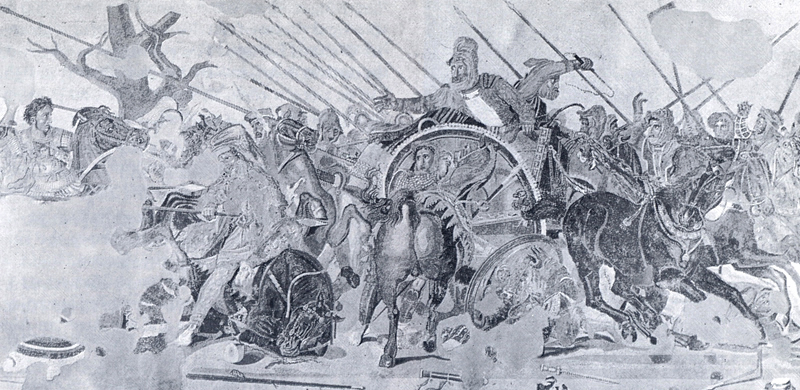
Alexander mosaic 3rd c. BC
Algardi Alessandro (1598–1654). Bolognese sculptor. After studying at the Carracci Academy he settled c. 1625 in Rome, where his friends included Domenichino, N. Poussin and Sacchi. A. excelled as a portraitist, particularly in the depth of his character analysis, e.g. his Francesco Bracciolini. Although A.’s approach was classical and although he was Bernini’s chief rival, his statue of Innocent X was influenced by the latter’s Urban VIII and above all his tomb for Leo XI (1645/50) is the first of many to be modelled on Bernini’s for Urban. From 1646 to 1653 A. was working on his relief of The Meeting of Attila and Leo I. With its modulation from the free-standing figures of the foreground to the shallow relief of the background, this was to be influential on later relief technique.
Algarotti Count Francesco (1712–64). Italian writer and connoisseur of art and music and a friend of Voltaire and Frederick II of Prussia. In Neutonianismo per le dame … (1737; trs. 1739) he popularized Newton’s optical theories, and the Saggio sopra l’opera in musica (1736; An Essay on the Opera, 1767) was a protest against the elaborate machinery of the 18th-c. stage. He was a friend of Canaletto and Tiepolo whom he influenced.
Aliamet Jean-Jacques (1726–88). French engraver. Executed engravings after C.-J. Vernet and 17th-c. Dutch painters, particularly N. Berchem. His brother, François-Germain (1734–88), also an engraver, worked in London under Sir R. Strange.
Alken Henry (1785–1851). Best known of a family of Danish sporting artists who settled in Britain. He was a prolific painter and watercolourist of hunting, coaching and shooting scenes and produced a famous series of aquatint prints. The quality of his work declined in the 1820s.
Allan David (1744–96). Scottish genre and portrait painter. He worked in Rome (1764–77) and won a prize there for a history painting. Sometimes called the ‘Scottish Hogarth’, more as a measure of his fame than his style.
Allan Sir William (1782–1850). Scottish history painter admired by Walter Scott. A. and Wilkie were largely responsible for establishing Scottish historical genre painting.
alla prima (It. at first). Method of painting in which the colour is applied in one session and no subsequent modification is made. In oil painting any previous drawing or under-painting is obliterated so that it does not affect the final result.
allegory. A story, whether in verse or in prose, or a painting in which the literal account or presentation is intended to have, or is interpreted as having, another and parallel meaning.
Allegretto Nuzi (di Nuzio) (1315/20–73). Italian painter working at Florence. He was affected by the Sienese school as well as by the work of Giotto. A. signed many of his pictures in full, which was unusual in the 14th c.
Allori Alessandro (1535–1607). Florentine painter. Used the name Bronzino after the death of his uncle, Il Bronzino. Studied under Bronzino and in Rome under Michelangelo. Although his drawing was rigid and his colouring cold he was popular as a painter of decorative frescoes into which he inserted portraits of prominent contemporaries. Cristofano (1577–1621), Mannerist painter, son of Alessandro. His painting united the rich colouring of the Venetian with the careful drawing of the Florentine school. His best-known painting is Judith with the Head of Holofernes. Judith is a portrait of his mistress Mazzafirra, while Holofernes is supposed to be a self-portrait.
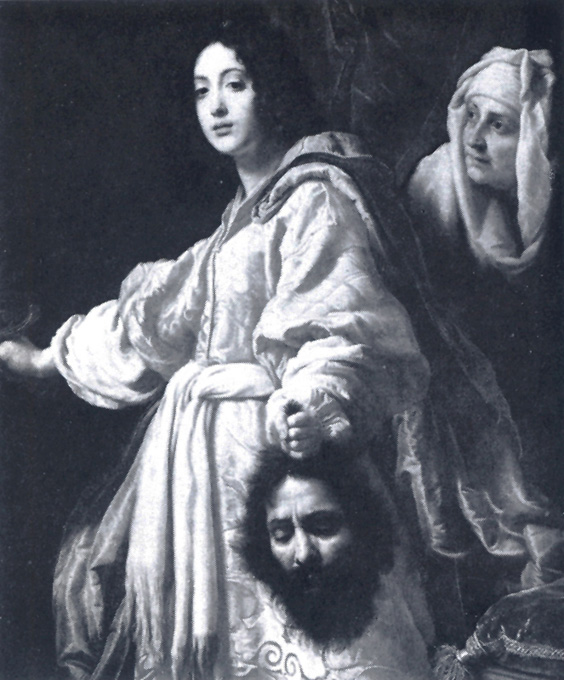
Cristofano Allori Judith with the Head of Holofernes early 17th c.
Allston Washington (1779–1843). U.S. painter and writer. In Europe (1801–10, 1811–18), he studied under B. West in London and visited Paris and Rome, becoming a close friend of S. T. Coleridge, W. Irving and B. Thorwaldsen. As the 1st U.S. artist to paint romantic landscapes he was a precursor of the Hudson River school; he also painted portraits, e.g. that of Coleridge, and large dramatic biblical and classical subjects. His Lectures on Art were publ. in 1850.
Alma-Tadema Sir Lawrence (1836–1912). Netherlands academic painter who settled in London (1870). He was very popular for his idealized, but accurately detailed and brilliantly coloured, scenes of Greek and Roman life.
Alsloot Denis van (d. c. 1626). Flemish painter who specialized in pageant and procession scenes.
Altamira. Limestone cave in Santander province, northern Spain, where animal paintings of the upper palaeolithic or leptolithic era were first discovered (1879). A.’s famous roof frieze of naturalistic bison is now recognized as late Magdalenian art c. 10,000 BC belonging to the final phase of the ice age hunting cultures of Western Europe. The paintings are executed in earth colours, mostly blacks and reds, straight on to porous rock; in some cases one painting is superimposed on another. Cave art.
Altdorfer Albrecht (c. 1480–1538). German painter and city architect and councillor of Regensburg, Bavaria. His St George is one of the first true landscape paintings in Europe. In it a mass of forest foliage soars above the tiny figures of St George and the dragon. Even in his early works, which show influences of L. Cranach and Dürer, landscape predominates, and a tour of the Danube and the Austrian Alps (c. 1511) confirmed his inclinations. An immediate result was the series of canvases, drawings and etchings of Danube landscapes (Danube school). Other major works are Alexander’s Victory, also called the Battle of Arbela (1529), and the St Florian Altar. This was eight panels depicting the life of St Florian, painted for St Florian’s church, near Linz, Austria. Seven of the panels are now in colls elsewhere; the Germanisches N.-Mus., Nuremberg; the Uffizi; and a private coll.
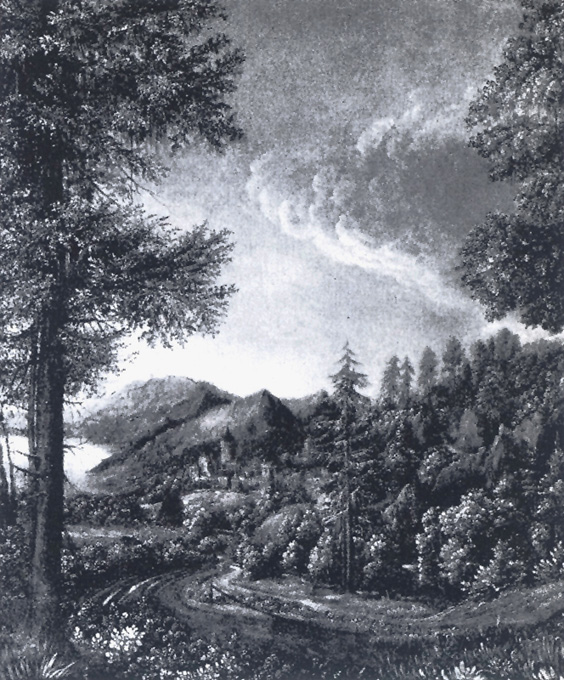
Altdorfer The Danube near Regensburg (detail) c. 1530
Altichiero da Zevio (fl. 1369–84). Italian painter from Verona. His figures are reminiscent of Giotto’s style but show a greater awareness of one another suggestive of later painters. There are frescoes by him in Verona and Padua including a great Crucifixion in the church of Sant’Antonio, Padua.
Alunno di Domenico (Disciple of Domenico, i.e. Ghirlandaio). Name given by Berenson to a Florentine painter and ill. (fl. late 15th-early 16th c.). His work included the predella for Ghirlandaio’s Adoration of the Magi (1488) for the church of the Innocenti, Florence. Berenson later discovered a contract (1488) made for the execution of this predella between the prior of the Innocenti and a Bartolommeo di Giovanni; he accepted this as the real name of his artist but retained the name A. as more instructive.
Amasis painter. Greek potter and vase painter in the black-figured style; his figures are lithe, vigorous and witty.
Amberger Christoph (c. 1500–c. 1561/2). German portrait painter whose work shows Venetian influence. Working in Augsburg he painted many famous people, including the Emperor Charles V (1532).
American Abstract Artists. U.S. group of painters formed in 1936, they included George L. K. Morris and Ibraham Lassaw. Their annual shows maintained a tradition of academic, if somewhat mannered, Cubism.
Amigoni Jacopo (1675–1752). Venetian Rococo painter who worked in various European countries and during his own lifetime was very popular.
Amman Jo(b)st (1539–91). Swiss woodcut artist and painter who settled in Nuremberg (1561), where he became a prolific ill. He executed woodcut ills for S. Feyerabend’s Bible (1564) and a set of 115 for a series on arts and trades.
Amman(n)ati Bartolommeo (1511–92). Florentine sculptor and architect. In Florence he carved the Neptune fountain (1563–77) in the Piazza della Signoria and built the famous Bridge of the Trinity (1567–9), destroyed in an air raid (1944), but since rebuilt, and extensions (1560–77) to the Pitti Palace. There are also buildings by A. in Rome and Lucca.
Amsler Samuel (1791–1849). Swiss engraver who worked in Munich, Germany. His work includes good reproductions of Raphael’s paintings and Triumphal March of Alexander the Great after a sculpture by Thorwaldsen.
Analytical Cubism. Cubism
Anamorphosis. Term of Greek origin referring to distorted image of a subject represented in drawing or painting, which will only reveal the image in true proportion when viewed from a certain point or reflected in a curved mirror (e.g. skull in Holbein’s Ambassadors).
Anderson Laurie (1947– ). U.S. Performance artist, composer and Postmodern poet. Her four-part work United States I–IV (1979–83), a 12-hour-long work presented solo by A. of theatrical entertainment took Performance art to the wider public. In her solo Performance Empty Places (1989) she deals with the U.S. sense of vastness and ‘the need to change, sometimes interpreted as freedom’.
Andokides. Greek vase painter in the red-figured style.
Andre Carl (1935– ). U.S. Minimalist sculptor. In 1964–5 he exhibited ‘primary structures’, e.g. Cedar Piece, piled-up timber, 6 ft (2 m.) high, for which Brancusi’s Endless Column (1937–8) was ‘the supreme inspiration’. From 1966 A. started his ‘scatter pieces’ on the floor, first using firebricks, e.g. Lever (1966), 29 ft (8.8 m.) of 137 aligned, loose bricks, and then, soon after, styrofoam bars and subsequently modular plates of copper, aluminium, steel, iron, magnesium, zinc or lead, e.g. Twelfth Copper Corner (1975) consisting of 78 plates of copper, each 19½ sq. in. (126 sq. cm.). These are his best-known works. Sometimes the flat plates are rich in colour, according to the metal used, and may be assembled as ‘particles’ on the floor in a chequerboard pattern of systemic units. A. defined sculpture as developing from ‘form’ to ‘structure’ and finally to ‘place’, i.e. the perception of the floorbound bricks or plates as sculpture depending on the site where they are presented and whether a particular sense of place is created.
Andrea del Castagno. Castagno
Andrea del Sarto ‘senza errori’, ‘the faultless painter’ (1486–1531). Florentine painter with feeling for tone and colour characteristic of the Venetian rather than the Florentine school. Invited by Francis I to Paris (1518) he returned to Florence (1519) to his wife. His life and works were much studied and admired in the 19th c. and Browning’s poem Andrea del Sarto was a sensitive and acceptable picture of a gifted, irresolute and reflective man. A.’s frescoes Birth of the Virgin (1514) and Madonna del Sacco (1525), both in S. Annunziata church, Florence, are perfect examples of the High Renaissance. Other major works include Madonna delle Arpie (1517), classical in style, and the Holy Family was a favourite theme. Among his pupils were the Mannerists da Pontormo and G. B. Rosso.
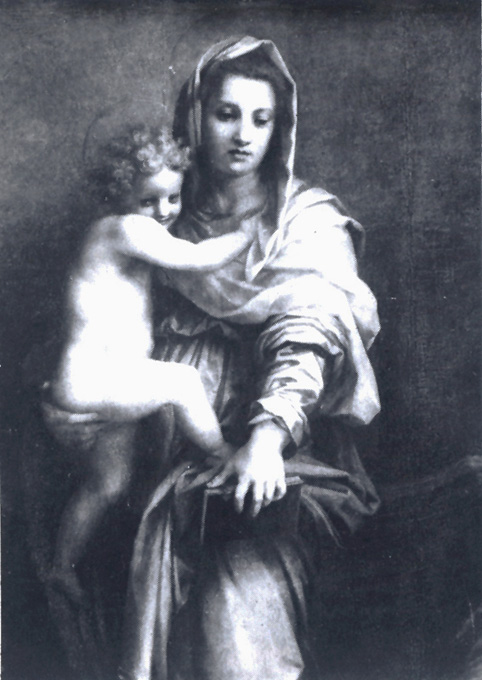
Andrea del Sarto Madonna delle Arpie (detail) 1517
Andrews Michael (1928–95). British painter of complex, but traditional subjects, which he summed up as pictures of ‘mysterious conventionality’. A. is best known for his series of party pictures painted after 1959, and for the series Lights (post-1970), as well as for his monumental landscapes of Australia.
Angelico, Fra (Giovanni da Fiesole) (c. 1387–1455). Italian painter celebrated for his frescoes in the convent of S. Marco, Florence. In 1407 he entered the Dominican convent of S. Domenico, Fiesole, near Florence, of which he was later prior (1449–52). Papal politics forced the community to leave Fiesole (1409–18) and some time after their return A. began to paint; nothing is known about his early training but he shows the influence of such international Gothic painters as Monaco. He executed (c. 1428–33) an altarpiece (extensively altered by di Credi, c. 1501) and 3 frescoes (sala capitolare of the convent) for his own convent and an Annunciation for the church of S. Domenico, Cortona; these foreshadow the simplicity of his mature work. In 1433 he was commissioned to paint the ‘Linaiuoli’ or Linen-workers’ triptych, particularly famous for the 12 angels playing on musical instruments which decorate the frame surrounding the central figures of the Virgin and Child. Two triptychs, painted after this for the churches of S. Domenico, Cortona and Perugia in the Gothic style, show that A. was attempting to break with the conventions of this form of altarpiece. In 1436 Cosimo de’ Medici commissioned A. to paint 3 altarpieces including the high altar for the Dominican convent of S. Marco, Florence – Virgin and Child Enthroned with SS Cosmas and Damian (1438–40). In these and the slightly earlier Coronation of the Virgin for Fiesole the figures of saints and angels recede towards the central figure, marking a step in the development of the sacra conversazione altarpiece. A. also uses single panels instead of the triptych and completely abandons the Gothic gold background; in the S. Marco altarpiece he introduces landscape background. The predella scenes for this altarpiece from the lives of SS Cosmas and Damian illustrate A.’s excellence as a colourist and are his most lively narrative paintings. A. began, about this time, to supervise the painting of 50 frescoes of scenes from the life of Christ for the cells of the convent of S. Marco; he himself probably painted not more than 10. Their setting and purpose, which was not decorative but to act as an aid to meditation, were ideally suited to the direct and simple piety characteristic of A.’s painting. Those by him are the most straightforward and hence most effectively fulfil their purpose. In 1447 he was in Orvieto where he painted The Last Judgement, finished by Signorelli, and in Rome executing decorative work in the Vatican for Pope Nicholas V. Only his frescoes in the chapel of Nicholas V (1447/8) survive. In keeping with their setting these are richer and more complex than any of A.’s previous work. A. died in Rome. Much of A.’s work refers back to Giotto and he took no part in the artistic experiments and secular interests of his contemporaries, although he utilized new visual techniques such as perspective if they served the devotional purpose of his painting. Gozzoli was his pupil.
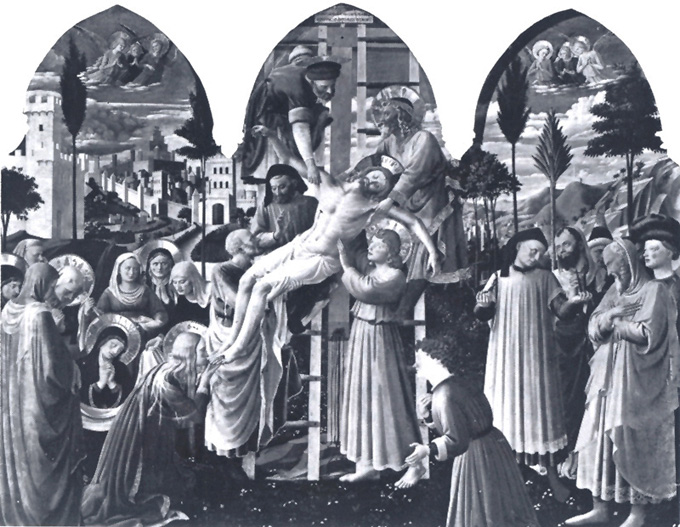
Fra Angelico Deposition c. 1436
Anguissola Sofonisba (1530s–1625). Italian painter, perhaps the best-known female artist of the 16th c., influenced, as were many of her contemporaries, by Titian. She mainly produced portraits and self-portraits. Her pursuit of a professional career did not conflict with contemporary notions of womanhood, largely because of her noble birth, and she was hailed as a prodigal exception. A. trained for 3 years under the man who appears in her Bernadino Campi Painting Sofonisba Anguissola (late 1550s), in which she portrays herself as his subject. From 1559–80 she was court painter to the Queen of Spain.
Animal style. Used generally to refer to Germanic animal ornament from the 5th c. to the period of the Renaissance. Based on 4th-c. provincial Roman prototypes, the forms became increasingly abstract: in the 5th c. broken up into separate, very stylized elements and linked together with obvious coherence; in the 6th c. elongated and interlaced into rhythmic snake-like patterns. A. s. reached its greatest refinement in Scandinavia.

Animal style Silver nielloed brooch, 5th c.
Annesley David (1936– ). British abstract sculptor. At first influenced by Caro, A. produces characteristic works of thin, colourfully painted, sheet steel.
Annigoni Pietro (1910–88). Italian painter and highly successful society portraitist, notably of British royalty.
Anselmo Giovanni (1934– ). Italian artist who works with stone, metal, wood and whose concerns are energy, gravity, space, time and infinity, e.g. Verso Infinito (1969). One of the original members of the Arte Povera group whose proponent Germano Celant said of A.’s work that it ‘exalts precariousness’. From 1969 he began using words which more explicitly connected images and ideas as in Conceptual art. In the 1980s A. created site-specific installations.
Antelami Benedetto (12th c.). N. Italian Romanesque sculptor. He executed a relief of the Deposition (1178) and other work in Parma cathedral.
Antenor (late 6th c. BC). Important Greek sculptor who worked in Athens. Works attributed to A. are in the Acropolis Museum, Athens, and the pedimental sculpture of the Archaic temple of Apollo at Delphi.
anti-cerne (Fr. cerne, outline). The opposite of a black outline; it is a contour effected by leaving a bare strip of ground between 2 or more areas of colour.
Antonello da Messina (c. 1430–79). Sicilian painter. In Naples he saw work by Netherlandish artists and may have studied under Colantonio, whose style was based on that of J. van Eyck. He learnt Van Eyck’s method of oil painting and achieved a delicate synthesis between the Northern and Italian styles. Working in Venice (1475) he passed his knowledge on to G. Bellini, altering his manner of painting and through him exercising great influence on the development of the Venetian school. His paintings include St Sebastian, Crucifixion, Portrait of a Young Man, St Jerome in his Study and Condottiere.
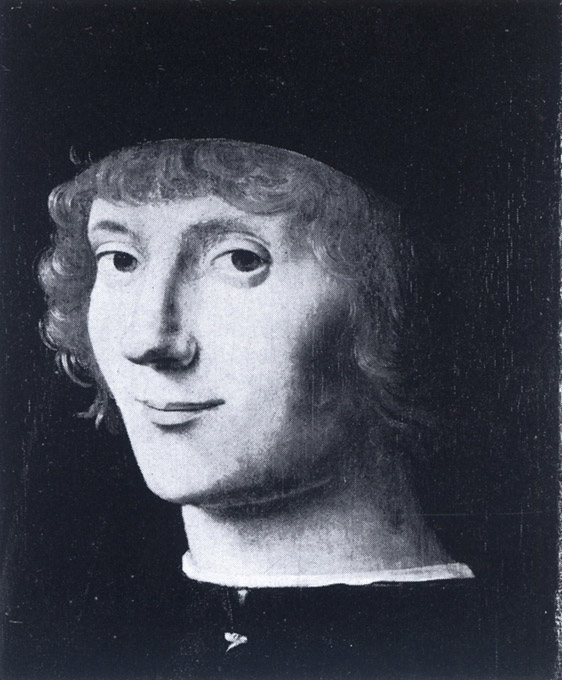
Antonello Portrait of a Young Man c. 1470
Antwerp Mannerists. Group of Antwerp painters of the early 16th c. whose work is characterized by Italianate ornamentation and affected attitudes. Unconnected with later Mannerism.
Apelles (fl. mid-4th c. BC). Greek painter who studied near Corinth under Pamphilos. He became court painter to Philip and Alexander the Great, whose portrait he alone was permitted to paint. His reputation rests simply on literary references since none of his paintings nor his treatise on painting survive.
Apollinaire Guillaume. The adopted name of Wilhelm Apollinaris de Kostrowitsky (1880–1918). French poet (naturalized 1914) of Polish-Italian parentage. A. went to Paris in 1898, becoming a leader of the revolutionary artistic and literary movements there. In 1908 he joined the Groupe du Bateau-Lavoir centred upon Picasso and Braque and the same year introduced Léger to the group. With publ. in 1913 of his poems Alcools and the essay Les Peintres cubistes (Cubist Painters in Documents of Modern Art, vol. i, ed. R. Motherwell, 1944) his importance as poet and publicist became obvious. His poetry broke with all traditions and disciplines, in subject matter, style, punctuation and typography and Les Peintres cubistes helped define the new school in painting. Works include his collected poems Calligrammes (1918) and the play Les Mamelles de Tirésias (1917) which he described as ‘une drame surréaliste’. A. christened Orphism and Breton and Philippe Soupault adopted the term Surrealism in homage to him.
Apollodoros (5th c. BC). Greek painter famous for panel as opposed to wall paintings and called ‘skiagraphos’ (‘the shadow painter’) because he introduced shading into his work to achieve more naturalistic effects. He also experimented with foreshortening.
Appel Karel (1921–2006). Dutch painter. He travelled widely in Europe, becoming in 1948 a leader in the Dutch Reflex group which, in 1948, became the international Cobra group. His hallmarks are violent colours and an impassioned style stemming from Van Gogh and the Expressionists.
Applebroog Ida (1929– ). U.S. artist living and working in N.Y.C. Having first worked in performance, film and sculpture, since 1974 she has emerged as one of the most serious and interesting U.S. feminist Postmodern painters. Her cartoon-like drawings in separate panels, using ink and rhoplex on parchment-like stiff vellum, were an offshoot of Conceptual art – she uses words and pictures which appear to be, yet defy, narrative. In these, as in her large multi-panel paintings, sometimes freestanding two-sided canvases, as well as on the wall, e.g. the series ‘Marginalia’ (1991), A. deals with issues of power/powerlessness, alienation, ‘the failure of individuals to connect’, public vs. private feelings, disaffection, rejection, humiliation and what amounts to the near-breakdown of communication in our society. Her technique, using the palette knife to build up the dominant images in muted browns, reds and yellows, is contrasted to the smaller, often repetitive, scenes drawn like comic strips around the main image.
Appropriation art. The direct duplication, copying or incorporation of an image (painting, photograph, etc.) by another artist who represents it in a different context, thus completely altering its meaning and questioning notions of originality and authencity.
Apt Ulrich or Abt, the Elder. Late 15th- to early 16th-c. German painter. His works include the Matthäus Altarpiece and the dramatic and experimental Lamentation over the Dead Christ, both in Munich. The Portrait of a Young Man, discovered in the 19th c., was remarkably like A.’s work but showed the initials ‘L.S.’ on a piece of armour. A.’s best works were reattributed to ‘L.S.’ until it was recently shown that the initials were simply those of the armourer.
aquarelle (Fr. watercolour). A painting executed in transparent watercolour. The term is sometimes applied to delicate music.
aquatint. Engraving technique whereby the etching plate is coated with porous resin resulting in prints with granulated effects, giving impression similar to wash drawings.
Arakawa Shusaku (1936–2010). Japanese painter who lived in N.Y., best known post-1970 for his paintings of words on large canvases, which function as symbols of images.
Arawak. Aboriginal people of the Caribbean, now extinct, whose art survives in cult images of wood, stone, bone, shell and clay. Although the figures are highly stylized, details of face, torso and joints are realistically rendered. The figures were embellished with gold ornaments.
archaic. In Greek art, the period c. 700–480 BC, especially in sculpture, e.g. the kouroi and korai (nude youths and draped girls) from the Acropolis. Figures are stiff and formalized (Egyptian influence) gradually becoming more naturalistic. In vase painting the a. period includes Corinthian, Attic black-figure and the earliest red-figure, in architecture early Doric (e.g. Paestum) and early Ionic (e.g. 1st temple of Artemis at Ephesus).
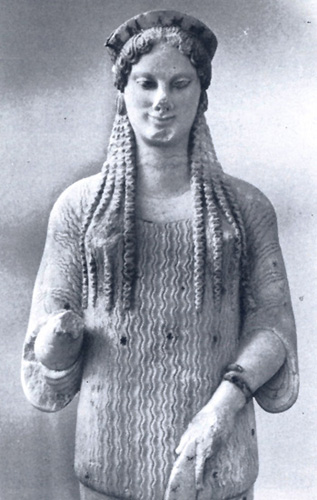
Archaic Marble Kore c. 510 BC
Archer Frederic Scott (1813–57). British photographer who in 1851 invented the colodion negative, thereby replacing the daguerreotype. He was also a sculptor.
Archipenko Alexander (1887–1964). Sculptor born in Kiev. He went to Paris in 1908 and soon made contact with the Cubists; his work was among the most important in the development of the new styles in 20th-c. sculpture. From essentially Cubist premises he evolved new approaches and techniques introducing (1912), for example, collage in sculpture, i.e. using wood, metal and glass, etc., on the same work. His Boxers (1913) is an important landmark in the assimilation by modern sculptors of the vitalist nature of primitive art.
architectonic. Term used metaphorically of a work of art with a structural pattern reminiscent of architecture in its rhythm and balance. The term is often applied to contrapuntal music where repeated themes, references and recollections of earlier material accumulate to give an effect of balance and a sense of architectural structure. The themes themselves often have a similar coherence.
Arcimboldo Giuseppe (1537–93). Milanese painter sometimes considered an ancestor of the Surrealists by virtue of his fantasy portrait heads; these are made up of fruit, vegetables, flowers, fragments of landscape, birds, animals, human bodies, tools, weapons, etc. Worked (in conventional style) at Milan cathedral and as painter to the Hapsburg court at Prague (1562–87).
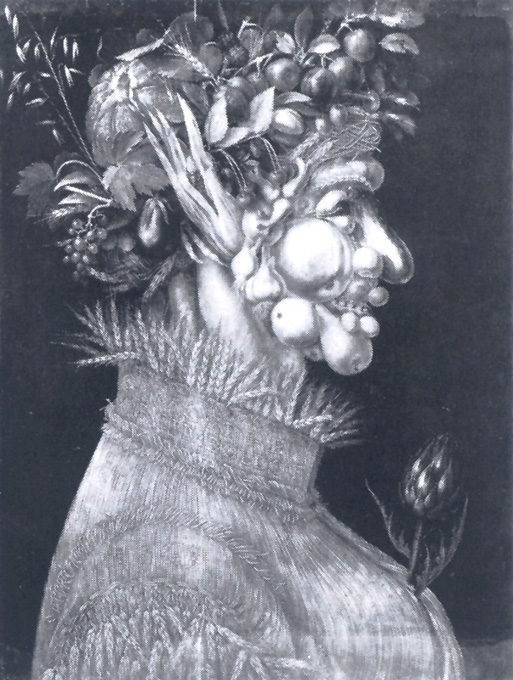
Arcimboldo Summer 1563
Ardizzone Edward Jeffrey Irving (1900–79). British artist in etching, lithography, pen drawing and watercolour. He was an official war artist (1940–5). He ill. more than 130 books, including children’s books, e.g. Tim All Alone (1956), and an edition of Villon’s poems and publ. Diary of A War Artist (1974).
Arentsz Arent (1585/6–before October 1635). Dutch landscape painter. Like H. Avercamp’s, his landscapes are heavily populated with figure groups.
Arikha Avigdor (1929–2010). Israeli painter, print maker and writer on art. Born in Bukovina, he lived and worked in Paris from 1949. A. was one of the most original and accomplished figurative artists who first became known as an abstract painter. He stopped painting in 1965 and drew from life until 1973. A. curated exhibitions and wrote on Poussin, Ingres, etc.
Aristides (4th c. BC). Greek painter renowned for the pathos of his figures. His most famous painting showed a dying mother in a conquered city shielding her baby from the blood on her breast.
Arman Armand Pierre (1928–2005). Franco-American assemblage artist, a member of the Nouveau réalisme group, influenced by Klein. He worked on series like poubelles (trash cans, displaying their contents) and accumulations (e.g. a cube 1m. cubed in volume full of toothbrushes), which are ironic statements about the detritus of the consumer society, décollage, Rotella, Villeglé, Hains and Vostell.
armature. Metal framework used in modelling and sculpture to support the clay or other material and prevent it sagging or collapsing.
Armitage Kenneth (1916–2002). British sculptor. In 1956 he won a competition for a war memorial at Krefeld. He was shown in the 1963 Darmstadt exhibition ‘Evidences of Anxiety in Modern Art’. A. worked almost entirely in plaster cast into bronze, concentrating on achieving an effect of movement and vitality in his figures, notable in the Walking Group (1951). His works include the Figure Lying on its Side, No. 5 (1959) and Pandarus 8 (1963).
Armleder John Michael (1948– ). Swiss artist known for combining pictures (of simple and random designs with references to formal abstraction) and objects (furniture, anonymous consumer articles and musical instruments) which interact in installations, e.g. ‘Furniture Sculptures’ of the 1980s.
Armory Show (17 February–15 March 1913). Highly influential international exhibition of over 1100 works by modern artists held in N.Y. at the armoury of the 69th Regiment. Fauvists, Cubists and other Paris-based artists (including Duchamp) received their first proper showing in the U.S.A. and the exhibition had a major impact on U.S. art and criticism. The A. S. was organized by the Association of American Painters and Sculptors and supported by the group The Eight. It subsequently moved to the Art Institute, Chicago.
Armstrong John (1893–1973). British painter, a member (1933) of the Unit One group. A.’s style, partly influenced by Surrealism, includes murals and theatre designs.
Arnolfo di Cambio (c. 1232–1302). Italian sculptor and architect. Assistant to N. Pisano both on the shrine of S. Dominic in Bologna and the pulpit at Siena. His statue of Charles of Anjou (before 1277) is the 1st modern portrait statue by a known artist and the design of his wall tomb of Cardinal de Braye (the cardinal lies on a bier beneath the Madonna and Child in glory) was a model for over a c. A. was an architect of the cathedral of S. Maria del Fiore and the church of S. Croce, both Florence, and also carved the sculptural decoration on the cathedral facade.
Arp Jean or Hans (1888–1966). Alsatian sculptor, graphic artist, painter and writer. He exhibited with Der Blaue Reiter artists and contributed to Der Sturm, and his interest in poetry inspired a great deal of his graphic work. In 1915 he moved to Zürich and, together with his wife, Sophie Taeuber, started to make collages according to the ‘law of chance’. In 1916/17 he made his 1st abstract sculptures; he participated in the Dada movement and the 1st Surrealist exhibition in 1925. In addition to sculptures, reliefs (one at the Unesco building in Paris), collages and drawings, A. also designed tapestries and wrote much, both poetry and prose in French and German. His works are usually or near abstract but nevertheless identify themselves quite clearly with natural forms.
Arpino Giuseppe Cesari (called ‘Chevalier d’Arpino’) (1568–1640). One of the last and most conservative of Italian Mannerist painters. He designed the mosaics for the dome of St Peter’s, Rome, and painted the frescoes in S. Martino, Naples (1589–91), and a series of large histories in the Conservatori Palace, Rome (1591–1636). Caravaggio was his pupil.
Arroyo Eduardo (1937– ). Prolific Spanish artist, based in France and Italy until Franco’s death in 1975, whose politically and culturally radical targets were not only political conservatism but also new art orthodoxies. He attacked Duchamp (Live and Let Die: The Tragic End of Marcel Duchamp, 1965) and the Nouveau réalisme group, Miró and Dalí. Co-founder of the Salon de la Jeune Peinture in 1963, A.’s aim was to create ‘art that engages the spirit of art more than its vocabulary’, a statement which characterizes all his activities. In solidarity with Cuban intellectuals, he and other members of Jeune Peinture painted a mural in homage to the Cuban Revolution and organized a ‘Salle Rouge pour le Viêtnam’. In 1968 they started the Atelier Populaire at the École des Beaux-Arts, Paris, producing more than 300,000 posters. A.’s passionate commitment to radicalism informs his idiosyncratic, often autobiographical, work, which also has great formal qualities recognized widely after the 1980s.
Ars moriendi (Lat. art of dying). Title of a famous block-book of a popular devotional character printed in Germany c. 1465. The earliest British version Ars moriendi, that is to saye the craft for to deye for the helthe of mannes sowle was printed by Caxton c. 1491.
Art & Language. In 1968 the British artists Terry Atkinson, David Bainbridge, Michael Baldwin and Harold Hurrell founded the Art & Language Press. In 1969 they launched their magazine Art-Language which presented art theory as Conceptual art. The A. & L. group’s views became influential in the U.S.A. and Europe.
Art Brut. Term coined by Dubuffet for art made by untrained people. Outsider art.
Arte Povera (It. impoverished art). Term coined by the Italian critic Germano Celant in 1968 to describe post-Minimalist art produced in the late 1960s with ‘humble’ and commonly available materials, such as sand, wood, stones and newspaper. Some of the artists associated with A. P. were Anselmo, Fabro, G. Paolini and Pistoletto.
Art Nouveau. A style of decoration and architecture current in the 1890s and early 1900s. The name derives from a gallery for interior decoration opened in Paris in 1896, called the ‘Maison de l’Art Nouveau’; the same style in Germany is called ‘Jugendstil’ after a magazine called Die Jugend (Youth) and in Italy ‘Floreale’ or ‘Liberty’ after the London store. Characteristic decorative motifs are writhing plant forms, as in the wrought-iron entrances to Paris Métro stations (by Hector Guimard). Similar forms were used both in book ills and also in the applied arts, e.g. furniture or glassware of the French artist Emile Gallé and of Louis Tiffany in the U.S.A. The best-known graphic artist is A. Beardsley, whose sinister line drawings were exceptionally well adapted to book ill. The architectural movement was widespread, leading figures being C. R. Mackintosh, and Antoni Gaudí in Barcelona, whose work has a bold fantastic style. Interior decorators include Samuel Bing (Germany), Victor Horta and Henry Van de Velde (Belgium).
Artschwager Richard (1923– ). U.S. painter and sculptor. While at Cornell University, Ithaca, N.Y., where he read chemistry and biology, he took painting and drawing classes. He then studied with Ozenfant 1949–50 before temporarily turning away from painting. In N.Y. he ran a woodwork studio where he started making furniture. In the 1960s he became involved with art full time and continued to explore the theme of furniture through 3-dimensional constructions of painted or polychrome wood. A. also paints large, usually monochrome depictions of interiors, buildings and objects on celofex.
Asam Cosmas and Egid, sons of the Bavarian painter Hans Georg (1649–1711), were church decorators and designers in whose work S. German Baroque achieved its zenith. Cosmas Damian (1686–1739) was a painter and architect of the monastic church of Weltenburg (1717–21). In his painting illusionism is carried to its furthest extremes, e.g. his frescoes in the church of Maria Viktoria, Ingolstadt (1736), and the Alteglofsheim Palace in Brevnov (1730). His use of light colours tends to the style of Rococo. Like his brother he held high positions in S. German courts. Egid Quirin (1692–1750) was stucco-worker, sculptor and architect; his churches include the collegiate church at Rohr (1718–25) and St Johann Nepomuk (called the Asam) church, Munich (1733–c. 1750), although Cosmas may have helped in the latter. All his sculpture of any importance is designed for churches and his best works are his altarpieces, e.g. the Assumption of the Virgin at Rohr and the St George at Weltenburg. The brothers worked in such harmony that it is usually difficult to distinguish their work. They were employed to redecorate Romanesque or Gothic churches (as at Freising cathedral, 1723/4, or St Emmeram’s church, Regensburg) but their masterpiece is the S. Johann Nepomuk church, Munich, where painting, sculpture, stucco and architecture serve the illusive confusion of the real and imaginary worlds (Baroque).
Ashanti. A people of Ghana. The gold encrusted stool, former symbol of A. royalty, was the most renowned example of A. metal work. Bronze was used for ritual urns, kuduo, and gold weights – human or animal figurines of proverbial subjects. The disc-headed fertility dolls, akua’ba, are the best-known examples of A. wood carving.
Ashcan school. Name given in the 1930s to early 20th-c. U.S. realist painters including some members of The Eight – Bellows and Jerome Myers – because of their preference for painting the unattractive aspects of city life.
Asselyn Jan (1610–52). Dutch painter. After visiting Rome he began to paint Italianate landscapes in the manner of Claude Lorrain, being one of the 1st in Holland to do so. His best-known, though not his most characteristic, work is The Angry Swan, an allegory of Dutch independence.
assemblage. A process comparable to collage in which the art object is built up from 3-dimensional found materials, combines and readymades.
Assisi. Town in Perugia, Italy; the birthplace of Sextus Propertius and St Francis of A. On Monte Subasio are the Franciscan monastery and the lower and upper churches of St Francis, built 1228–53 in Gothic style. The lower contains frescoes over the high altar by Giotto, illustrating the vows of the Franciscan order, and others attributed to Cimabue; the upper, frescoes by Giotto and pupils showing scenes from the life of St Francis. The oratory (or Porziuncola) of St Francis and the cell in which he died are in the church of Santa Maria degli Angeli which was built round them (1569–79; rebuilt after 1832). The basilica at A. was begun c. 1132.
Assyrian art. A. a. is predominantly represented by sculpture from the palaces of imperial rulers (883–612 BC). Conspicuous are colossal portal-figures of winged bulls or lions and a wealth of mural relief carvings in stone. Documentary or narrative scenes show foreign exploits of the king’s armies or victory celebrations, followed by relaxation in hunting: all depicted with unparalleled stylistic vitality. Fine craftsmanship is also evident in the carved ivory enrichment of furniture, where Phoenician designs are reflected but later surpassed in grace and refinement.
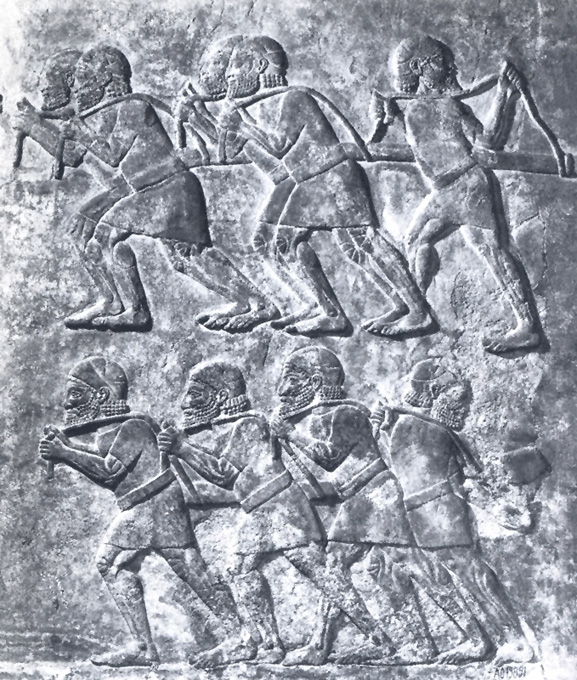
Assyrian art Slaves unloading timber (relief from the Palace of King Sargon II) 721–705 BC
atelier (Fr. studio). Used of a painter’s or sculptor’s studio or collectively of the pupils gathered round a master. Atelier libre (or sometimes académie) is a studio in which a model is provided but no tuition given. Famous paintings of a.s are Courbet’s Atelier du peintre (1855), painted as an allegorical manifesto of Realism, and Fantin-Latour’s L’Atelier des Batignolles or Hommage à Manet (1869) showing Manet with Renoir, Monet, Bazille, Zola, etc.
Atelier 17. Founded in Paris in 1927 by the British engraver S. W. Hayter for research into new graphic techniques. It became one of the most influential schools for graphic art.
Atkinson Lawrence (1873–1931). British painter, sculptor, writer and musician. Worked 1st as a painter, and later concentrated on sculpture. He was among the signatories of the Vorticist Manifesto published in BLAST, No. 1, 1914.
Attiret Jean-Denis (1702–68). French painter who in the 1730s became a Jesuit and went as a missionary to China where he became court painter at Peking. His later work is in the Chinese manner.
Audubon John James (1785–1851). U.S. naturalist and artist who painted from life 435 watercolours of birds, often in action, which were reproduced in coloured aquatint by Robert Havell Jr. and publ. in London as The Birds of America (4 vols, 1827–38); only these prints survive. The text, written with the help of William MacGillivray, was publ. separately as Ornithological Biography (5 vols, 1831–9). A.’s paintings have considerable artistic merit although their scientific accuracy varies.
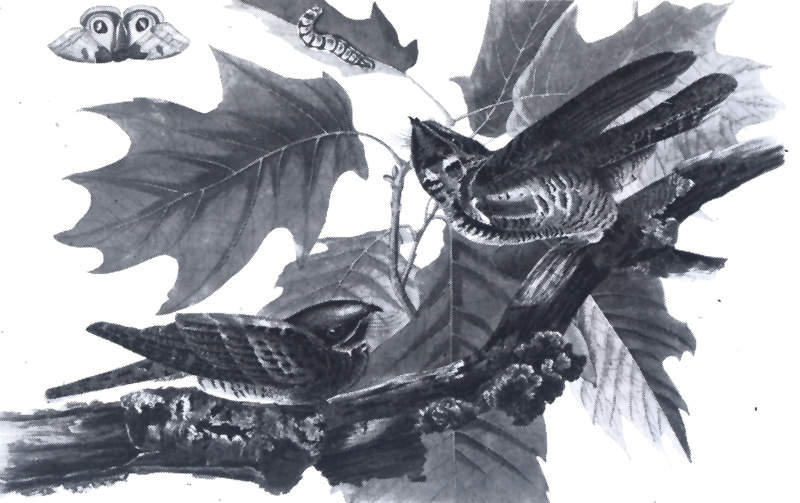
Audubon The whip-poor-will from The Birds of America 1827–38
Auerbach Frank (1931– ). Born in Berlin, he moved permanently to Britain in 1939. A. studied at St Martin’s School of Art, London, and at the Royal College of Art. He was taught and influenced by Bomberg who encouraged him to look back, beyond Cubism, to Cézanne. His work is modern, but in the tradition of Géricault, Delacroix, Ingres, Courbet and Daumier; he is one of the most accomplished figurative artists of his generation. His subjects are portraits of friends, and landscapes.
Augustin Jacques-Jean-Baptiste (1759–1832). French miniaturist who revived the art in France; his paintings have strong, pure colours, certainty of execution and high finish.
Australian Aboriginal art. This consists largely of paintings and carvings on rock, carvings on body ornaments and cult objects such as churingas and bull roarers, and bark paintings. Abstract styles, e.g. spiral designs, and naturalistic styles are found. Human figures and animals, such as fish, turtles and kangaroos, connected with the hunt or with totemic beliefs, are depicted. Melanesian influences through New Guinea may account for the squatting figure motifs, rich colouring and other aspects of paintings in N. Arnhem Land and N.W. Australia. The huge wondjina ancestor-skull pictures depict dark-haloed heads without mouths. Animals are shown realistically and also in ‘X-ray’ style, where the skeleton and organs of interest to the hunter are depicted schematically within the body outline. There is a rich oral tradition of myth, relating the ancestral time, ‘The Dreaming’, to the present in an unbroken continuum.
Automatism. In writing or painting, the suspension of the control of reason allowing the release of subconscious imagery. It is chiefly associated with Surrealism and described in Breton’s Manifeste du Surréalisme (1924) as ‘pure psychic automatism’. It was subsequently developed by the Abstract Expressionists.
Automne, Salons d’. Opened in 1903 with an exhibition of Gauguin’s works which was influential on younger artists. The controversial 1905 Salon d’Automne first presented the Fauve artists, with Matisse, Bonnard and Marquet, among others, participating.
Avant-garde (Fr. vanguard). Term applied to the group of artists, writers, etc. thought at any given time to be most ‘advanced’ in their techniques or subject matter.
Aved Jacques (1702–66). French portrait painter who studied in Amsterdam and unlike his French contemporaries usually painted his subjects in their normal dress and surroundings. He urged his friend Chardin to take up portraiture and their work has sometimes been confused.
Avercamp Hendrik (1585–1634). Dutch landscape painter who specialized in winter landscapes with numerous tiny figures.
Avery Milton Clark (1893–1965). U.S. figurative artist who continued and developed Matisse’s abstracting tendencies and flat colour masses. Starkness of presentation and force and clarity of images in works like Mother and Child (1944), Swimmers and Sunbathers (1945), organized in areas of pure colour, anticipate the Abstract Expressionists: he was greatly admired by Gottlieb, Hofmann and Rothko.
Avignon school. 15th-c. French school of painting of which the leading known master was Quarton and the outstanding work the beautiful and austere anon. pietà. The school represents the final flowering of Avignon’s 14th-c. cultural ascendency during the papal exile.
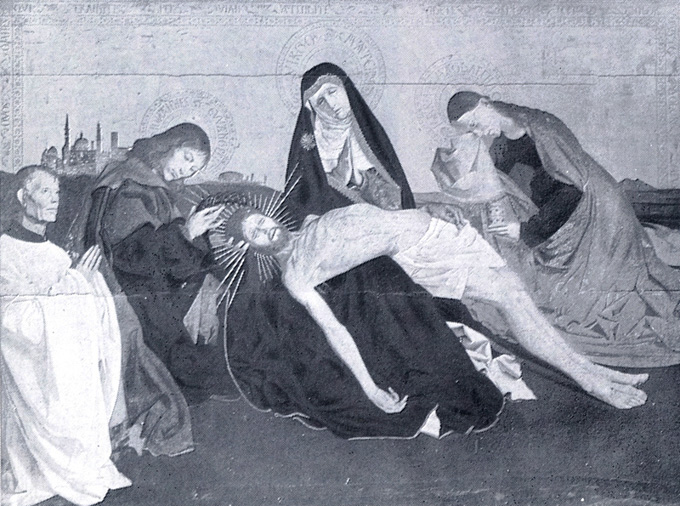
Avignon school Pietà 15th c.
Aycock Alice (1946– ). U.S. sculptor. She studied under R. Morris and developed an interest in architecture and ancient sites (e.g. Maze, 1972) transposed to contemporary situations, e.g. The True and False Project Entitled ‘The World is So Full of a Number of Things’ and Project Entitled ‘The Beginnings of a Complex’ (both 1977). A. later studied machine forms and mechanical forces and created large-scale installations, e.g. The Savage Sparkler (1981) and Tower of Babel (1986).
Ayrton Michael (né Gould) (1921–75). British figurative sculptor, painter, graphic artist, writer and critic. A.’s chief preoccupations were with the Greek myths of Daedalus, the Minotaur and the Delphic oracle, and the composer Berlioz. A.’s numerous books include: Testament of Daedalus (1962), The Rudiments of Paradise (1971) and The Minos Consequence (1974).
Aztec art. Pre-Columbian art